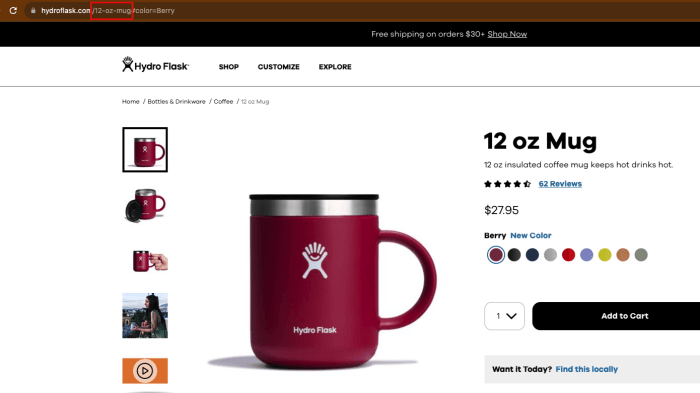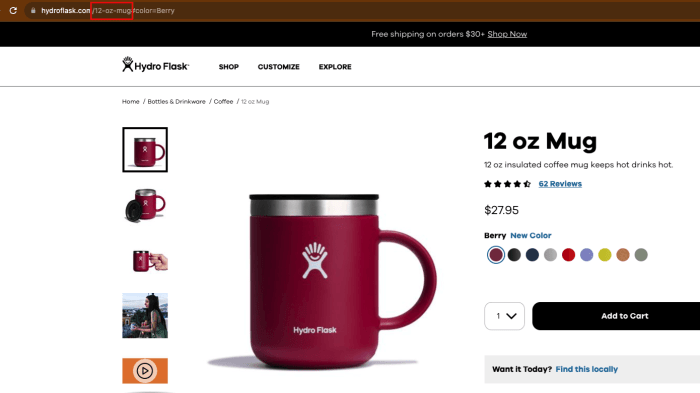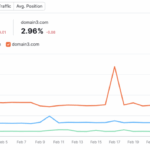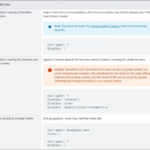What is a URL slug? It’s the friendly, user-friendly address that directs you to specific content on a website. Imagine a website as a sprawling library. Each book has a title, and the slug is like the call number or shelf location. This isn’t just about neat organization; it plays a crucial role in how users find information and how search engines understand your content.
From crafting clean, -friendly URLs to understanding the technical implementation behind the scenes, this guide explores every aspect of URL slugs. We’ll uncover how these seemingly small components significantly impact your website’s overall functionality, user experience, and search engine ranking.
Defining a URL Slug

A URL slug is a concise, human-readable part of a web address that represents a specific page or resource on a website. It’s a crucial element in website design, serving as a bridge between the technical structure and the user experience. A well-crafted slug can significantly improve how users navigate and understand your website, as well as boosting its search engine ranking.Slugs are more than just a string of characters; they are a critical component of a website’s architecture, directly impacting how users interact with and find content.
They contribute significantly to both user experience and search engine optimization ().
Definition of a URL Slug
A URL slug is a short, user-friendly text string that replaces the numerical ID or other technical identifiers in a URL. This makes the address more understandable to both humans and search engines. For instance, instead of a URL like `www.example.com/product?id=123`, a slug-based URL would be `www.example.com/product-name`.
Purpose of a URL Slug in Website Structure
Slugs are vital for improving website structure by enhancing the readability and searchability of web addresses. They replace complex or meaningless numerical IDs with descriptive words or phrases, leading to a more intuitive and user-friendly navigation experience. This approach streamlines how users understand the context of a page, and it can also make it easier for search engines to interpret the content of the page.
How Slugs Contribute to User Experience
Intuitive URLs, facilitated by slugs, are fundamental to a positive user experience. Users can quickly grasp the content of a page by simply looking at the URL. This makes it easier for them to navigate the site and find what they’re looking for. For example, a user can easily distinguish between pages about “best-selling-books” and “new-arrivals,” thanks to the clear and descriptive slugs.
A URL slug is simply the descriptive part of a URL, like “blog-post-title” in https://example.com/blog-post-title. Understanding slugs is crucial for SEO and user experience, but it also connects directly to the commandments of internal linking. Following those guidelines, like using descriptive slugs for internal links commandments of internal linking , helps search engines understand your site’s structure, making it easier for visitors to find what they’re looking for.
Ultimately, well-crafted slugs improve your site’s navigation and user experience.
This improved understanding leads to greater user satisfaction and potentially higher engagement with the site.
Simple Example of a URL with a Slug
Consider a website selling electronics. A URL without a slug might look like this: `www.electronicsstore.com/product?id=4711`. This is confusing for users. A URL with a slug, on the other hand, might look like this: `www.electronicsstore.com/products/best-smartphones`. The second example is much easier for users to understand and remember.
This user-friendliness is a significant aspect of improving the user experience.
A URL slug is basically the part of a website address that’s user-friendly and descriptive, like “blog-post-title” instead of a long string of numbers and characters. Understanding these slugs is crucial for SEO, as they play a vital role in how search engines understand your content. Knowing how to track keywords like “best coffee shops” or “best restaurants” in your region is equally important for your online visibility.
By analyzing your website’s traffic and the keywords people use to find you, you can optimize your slugs for better search engine rankings. Ultimately, crafting effective slugs is a key component in your overall SEO strategy. how to track keywords can help you understand the power of optimizing these important components. This helps you to understand your audience’s needs better, leading to improved visibility.
How Slugs Improve Search Engine Optimization ()
Search engines, like Google, use the text in URLs to understand the content of a page. Well-structured slugs, using relevant s, improve a website’s visibility in search results. This leads to more organic traffic and greater discoverability. For example, a slug like `www.example.com/best-running-shoes` is more likely to rank higher in search results for queries related to running shoes than a URL without descriptive s.
This increased visibility, driven by -friendly slugs, directly impacts a website’s online presence.
Structure and Composition
URL slugs, those concise strings that identify specific pages on a website, are more than just pretty URLs. They play a crucial role in search engine optimization () and user experience. Understanding their structure is key to creating effective and user-friendly web content. This section delves into the components of a typical URL slug, the significance of various characters, and the differences between slugs and full URLs.A well-crafted slug is easily readable by both users and search engines, making it an important element of a website’s architecture.
This clarity enhances discoverability and improves the overall site experience.
Components of a URL Slug
URL slugs typically consist of words or phrases separated by characters like hyphens or underscores. These components contribute to the clarity and meaning of the URL. The most important aspect is that the slug accurately reflects the content of the page. This improves search engine optimization and enhances user experience.
Role of Characters in Slugs
Hyphens (“-“), underscores (“_”), and other characters, when used correctly, can improve the readability and structure of a URL slug. They serve as separators between words or phrases, making the slug more easily understandable.Hyphens are the most common choice, often preferred by search engines. Underscores can be used, but their use varies across platforms and may not always be optimized for search engines.
The choice between hyphens and underscores can affect .
URL Slug vs. Full URL
A URL slug is a portion of a full URL. The full URL is the complete address of a web page, including the protocol (http or https), domain name, and path. The slug represents the specific page or resource within that website.A full URL might look like this: `https://www.example.com/products/best-running-shoes`. The slug in this case is `products/best-running-shoes`.
Understanding this distinction is crucial for optimizing your website’s structure.
Different Approaches to Creating Slugs
Several approaches exist for creating effective slugs. Some websites prioritize using s, while others focus on brevity and readability. Each approach has potential benefits and drawbacks.A key aspect is ensuring consistency across the entire website. Using a consistent approach to slug creation helps search engines and users understand the structure of the website.
Slug Naming Conventions
| Convention | Description | Example |
|---|---|---|
| -based | Emphasizes relevant s | /best-running-shoes-2024 |
| Descriptive | Clearly describes the page content | /products/men-s-running-shoes |
| Short & Sweet | Prioritizes conciseness | /running-shoes |
| Hyphenated | Uses hyphens as separators | /best-running-shoes |
| Underscored | Uses underscores as separators | /best_running_shoes |
The choice of convention depends on the specific needs of the website and its target audience. Consistency and clarity are key elements in any approach.
Slug Generation Methods: What Is A Url Slug
Generating -friendly and user-friendly URLs is crucial for a website’s success. Slugs play a significant role in this process, and the methods used to create them directly impact website performance and user experience. Different slug generation techniques offer varying degrees of control and flexibility, each with its own set of advantages and disadvantages.Automatic slug generation from content ensures consistency and reduces manual effort.
However, it’s essential to understand the different methods and their implications for website performance and . By choosing the right method, you can create a system that optimizes your website for both search engines and users.
Slug Generation Algorithms
Various algorithms are used to transform human-readable text into machine-readable slugs. These algorithms often employ a combination of steps to achieve a clean, concise, and -friendly URL structure.
- Replacement of special characters: Many algorithms start by removing special characters, punctuation, and accented characters from the input text. This process ensures the resulting slug contains only alphanumeric characters, making it suitable for URLs.
- Conversion to lowercase: Converting the text to lowercase is a standard practice to maintain consistency across different input formats and improve searchability. Lowercasing also ensures that URLs generated from the same text are identical, regardless of the original case.
- Removal of extra whitespace: Extra spaces, tabs, or newlines can lead to unnecessary repetition or ambiguity in the slug. Algorithms typically eliminate extra whitespace to create more concise and efficient URLs.
- Normalization and stemming: Normalization involves reducing words to their base form (e.g., “running” to “run”). Stemming takes this further, by reducing words to their root (e.g., “running” to “run”). This can help in generating more relevant slugs for similar topics, improving .
- Word separators: Algorithms employ separators (typically hyphens or underscores) to divide words within the slug. These separators enhance readability and improve the overall structure of the URL. For example, “this is a title” could become “this-is-a-title”.
Examples of Slug Generation Algorithms
A simple slug generation algorithm might involve removing spaces and converting to lowercase. A more complex algorithm might also include stemming and normalization to reduce variations in the input text.
| Input Text | Slug (Simple Algorithm) | Slug (Advanced Algorithm) |
|---|---|---|
| A Simple Blog Post | a-simple-blog-post | simple-blog-post |
| The Quick Brown Fox | the-quick-brown-fox | quick-brown-fox |
| My Long and Winding Road | my-long-and-winding-road | long-winding-road |
Advantages and Disadvantages of Different Methods
Different slug generation algorithms offer various advantages and disadvantages in terms of , readability, and website performance.
- Simple algorithms are faster to implement and execute, but they might not be as effective in terms of optimization. They might lead to less descriptive URLs and potentially higher risk of duplicate content.
- Advanced algorithms, such as those incorporating stemming and normalization, can improve by reducing variations in URLs and improving relevance. However, they can be more complex to implement and may take slightly longer to generate the slugs.
Impact on Website Performance
The chosen slug generation method directly influences website performance. Simple algorithms are generally faster, but more sophisticated methods might introduce minor delays during content generation.
- Impact on database queries: The complexity of the algorithm affects the time required to generate slugs, which in turn influences the performance of database queries.
- Server response time: Faster slug generation methods lead to quicker server response times, enhancing user experience. Slugs that take longer to generate can result in slower loading times for web pages.
Best Practices and Considerations
Crafting effective URLs is crucial for both user experience and search engine optimization (). Well-structured slugs contribute significantly to how easily users can navigate your website and how well search engines understand your content. A thoughtfully designed URL structure makes your site more accessible and discoverable.Optimizing your slugs for involves understanding the balance between user-friendliness and search engine crawlability.
A well-optimized slug clearly communicates the content of the page to both users and search engines. This ultimately translates into better rankings and more organic traffic.
Best Practices for -Friendly Slugs
Following best practices for slug creation directly impacts your website’s performance and discoverability. These practices ensure a smooth user experience and maximize search engine visibility.
- Conciseness and Relevance: Keep slugs short and to the point, using s that accurately reflect the page’s content. Avoid overly long or vague descriptions. A concise slug helps users quickly grasp the page’s subject and search engines understand the topic more efficiently.
- Readability and Searchability: Employ clear and simple language in your slugs. Use hyphens to separate words for improved readability and search engine comprehension. Avoid using special characters that might be misinterpreted by search engines or browsers. Choose s that users would naturally use when searching for your content.
- Handling Special Characters and Internationalization: When dealing with international characters, ensure your slug encoding supports these characters correctly. Use a consistent character encoding (e.g., UTF-8) to prevent issues with display and indexing. Employ URL-safe characters to avoid conflicts with browsers and search engines.
Examples of Good and Bad Slug Practices
Illustrating good and bad practices helps in understanding the importance of clear and concise URL slugs. These examples showcase how different approaches impact both user experience and search engine optimization.
| Good Practice | Bad Practice | Explanation |
|---|---|---|
| /blog/how-to-write-a-great-article | /blog/how-to-write-a-great-article-tips-tricks-and-more | The first example is clear, concise, and uses relevant s. The second example is unnecessarily long and includes irrelevant words. |
| /products/red-leather-jacket | /products/redleatherjacket | The first example is readable and uses hyphens to separate words. The second example is difficult to read and uses no spaces or hyphens. |
| /recipes/best-chocolate-brownie | /recipes/the-best-chocolate-brownie-recipe-ever | The first example is concise, using only relevant s. The second example is excessively verbose and less effective for . |
Optimizing for Readability and Searchability
Optimizing slugs for readability and searchability is crucial for both users and search engines. Clear and concise slugs help users understand the content and allow search engines to effectively index and rank the pages.
- Integration: Incorporate relevant s into your slugs, but avoid stuffing. Naturally incorporate terms that accurately reflect the content of the page. This approach helps search engines understand the page’s topic and improves organic rankings.
- Hyphens for Word Separation: Use hyphens to separate words in your slugs, making them easier to read and understand. This improves readability and allows search engines to process the s effectively. This clear separation increases readability and assists with search engine indexing.
Impact on Website Functionality
URL slugs, those seemingly simple strings that define your website’s pages, play a crucial role in how your site functions and how users interact with it. They aren’t just pretty addresses; they are integral components of a well-structured and user-friendly website. Properly crafted slugs significantly influence navigation, architecture, and internal linking, ultimately impacting user experience and website performance.Effective slugs improve discoverability, enhance , and make the overall website experience more intuitive and logical.
This section delves into the specific ways slugs impact website functionality, demonstrating how thoughtful slug creation translates to a more effective and engaging online presence.
Influence on Website Navigation and User Interaction
Well-structured slugs make website navigation intuitive and user-friendly. Users can easily understand the content of a page just by looking at the URL. This clarity reduces the cognitive load on the user, allowing them to quickly find the information they need. For example, a slug like “/products/shoes/running-shoes” clearly indicates the page’s content, enabling users to easily browse and locate specific product categories.
Conversely, poorly constructed slugs like “/products34782” offer no contextual clues, hindering user navigation and increasing the time it takes to locate desired information.
Effect on Website Architecture and Organization, What is a url slug
Slugs directly reflect the website’s architecture and organization. A consistent and logical slug structure mirrors the site’s hierarchical structure, allowing users to easily understand the relationships between different pages. For instance, if a website sells apparel, a consistent slug structure such as “/men’s-clothing/shirts” and “/women’s-clothing/dresses” will intuitively guide users to the relevant sections, reflecting the site’s organizational design.
Conversely, inconsistent slugs can lead to a confusing and disjointed website structure, making it difficult for users to navigate and locate specific content.
Impact on Internal Linking Strategies
Internal linking is a crucial practice that helps users explore related content on a website. Effective slugs facilitate the creation of meaningful internal links, enabling search engines and users to understand the relationship between different pages. A site selling electronics with a slug structure like “/laptops/gaming-laptops” and “/laptops/ultra-portable-laptops” allows for linking these product pages with related content (reviews, comparisons, etc.) in a natural and logical way, enhancing user experience and .
Poorly structured slugs make internal linking challenging, hindering search engine crawling and reducing the effectiveness of internal linking strategies.
A URL slug is basically the user-friendly part of a website address. It’s the descriptive text that helps people understand what a specific page is about, like a mini-title. Understanding how these are structured can be incredibly useful in interpreting your website traffic. For example, using Google Analytics reports to improve marketing strategies, you can track which slugs perform best.
Knowing which URL slugs drive the most traffic is key to optimizing your website’s structure and content for better results. google analytics reports to improve marketing can help with that. A well-optimized slug structure contributes to a better user experience and ultimately higher search engine rankings, making it essential for online success.
How Slugs Improve Website Accessibility
Accessible websites prioritize user experience for all users, including those with disabilities. Descriptive and meaningful slugs are crucial for website accessibility. Using clear and concise slugs that accurately reflect the page’s content makes it easier for screen readers and other assistive technologies to interpret the page’s purpose. A slug like “/contact-us” is more accessible than a slug like “/page-5”.
This clear and concise slug structure allows users to easily navigate and understand the site’s content.
Role in Creating a Logical Website Structure
Logical website structures are essential for user experience and . Meaningful slugs contribute significantly to this structure. A consistent and descriptive slug structure mirrors the site’s content hierarchy, making it easier for users to find what they need. A site selling books with slugs like “/books/fiction/mystery” and “/books/non-fiction/history” establishes a clear and organized structure, enabling users to easily browse and locate desired books.
Conversely, poorly constructed slugs lead to a disorganized website structure, making it challenging for users to navigate and hindering search engine crawlers.
Slug vs. Other URL Elements
Understanding how slugs function within a URL structure is crucial for optimal website design and user experience. Beyond the slug itself, various other elements contribute to the complete URL, each impacting the site’s architecture and user interaction. Parameters, anchors, and slugs play distinct roles, influencing how users navigate and interact with content.This section delves into the distinctions between slugs, parameters, and anchors, analyzing their effects on website structure and user experience.
We’ll compare and contrast their functionalities, highlighting the unique advantages and disadvantages of each element.
Comparison of URL Elements
Different URL elements serve distinct purposes within the overall structure. Parameters, for example, are used to transmit dynamic data, while anchors are utilized for internal navigation or linking to specific sections within a page. Slugs, on the other hand, are integral to creating descriptive and -friendly URLs.
Impact on Website Structure
The choice of URL elements significantly impacts website architecture. Slugs, often used for categories or individual posts, help organize content logically. Parameters, by contrast, are more dynamic, allowing for variations in displayed content based on user input. Anchors offer a way to navigate within a page without altering the primary URL.
Impact on User Experience
The user experience is intrinsically linked to the URL structure. Well-structured URLs with descriptive slugs improve discoverability and allow users to easily identify content. Parameters, if not used carefully, can make URLs confusing or cumbersome, negatively affecting navigation. Similarly, anchors enhance internal navigation, improving the user’s ability to locate specific sections of a page.
Detailed Comparison Table
| Element | Description | Impact on Structure | Impact on User Experience | Pros | Cons |
|---|---|---|---|---|---|
| Slug | Descriptive part of a URL, typically used for content titles or categories. | Creates logical organization for content. | Improves readability and discoverability. | friendly, enhances navigation, clear content identification. | Can become complex with deep hierarchies. |
| Parameter | Dynamic data appended to the URL, often used for filtering or sorting. | Allows for flexible content display. | Can be confusing if not used effectively. | Allows for customization, facilitates dynamic content. | Can make URLs overly long and complex if misused. |
| Anchor | A reference to a specific part of a page within the URL. | Enhances internal navigation. | Provides quick access to specific content sections. | Facilitates seamless internal navigation. | Can be less effective for external linking. |
Interplay of Elements
These elements don’t function in isolation. A well-designed website utilizes slugs to organize content, parameters for dynamic display, and anchors for internal navigation. For instance, a blog post about “Best Coffee Makers” could have a URL like “/coffee-makers/best-coffee-makers-2024”. This slug helps users understand the content. If the page offers a filter to sort by price, a parameter could be added (e.g., “/coffee-makers/best-coffee-makers-2024?price=high”).
Using an anchor within the page allows direct access to the “reviews” section.
Technical Aspects of URL Slugs
URL slugs, while seemingly simple strings, play a crucial role in the technical underpinnings of web applications. Their implementation extends beyond aesthetics, impacting database interactions, content management, and overall server performance. Understanding these technical aspects is key to building robust and efficient websites.Implementing slugs effectively involves careful consideration of various factors. From the database queries used to retrieve content to the server-side logic handling requests, slugs must be handled with precision to ensure smooth functionality and data integrity.
Slug Implementation in Web Applications
The implementation of slugs in web applications often involves modifying the way URLs are handled. Typically, this involves using a routing system that translates the slug in the URL to the corresponding content item. Different web frameworks and content management systems (CMS) employ various approaches for achieving this translation. Some systems directly map slugs to database records, while others involve intermediary layers of logic.
The specific approach influences the performance and maintainability of the application.
Role of Slugs in Database Interactions
Slugs are integral to database interactions, often used as unique identifiers or keys for retrieving content. Efficient database queries rely on the proper indexing and structure of slug fields. Well-designed database schemas incorporate slugs as part of the primary key or use them in optimized search queries. This ensures rapid retrieval of content associated with specific slugs.
Importance of Proper Slug Handling for Data Integrity
Proper slug handling is crucial for maintaining data integrity. Inconsistent or incorrectly generated slugs can lead to broken links, missing content, or even security vulnerabilities. Robust validation and sanitization procedures are necessary to prevent these issues. For instance, ensuring that slugs adhere to specific character sets or length restrictions protects against potential injection attacks.
Technical Limitations and Constraints of URL Slugs
Technical limitations and constraints exist in implementing URL slugs. One constraint is the need to avoid conflicts between different content items. Slug generation mechanisms must guarantee uniqueness. Furthermore, slug lengths and character sets can be restricted by the underlying technologies. These limitations are crucial to understand and address during the design phase to avoid future issues.
Impact of Slugs on Server-Side Processing
Slugs affect server-side processing by influencing how the application handles requests. Efficient routing mechanisms are essential to translate slugs into corresponding content quickly. Optimization techniques like caching and database indexing play a vital role in improving performance. For example, a slow database query to retrieve a content item associated with a particular slug will have a direct impact on the user experience.
Slug Implementation in Different Platforms
URL slugs, those concise and readable representations of web page URLs, are crucial for and user experience. Implementing them effectively varies significantly across different platforms, from content management systems (CMS) to web frameworks. Understanding these variations is key to crafting a seamless and optimized online presence.
Content Management Systems (CMS)
Different CMS platforms offer varying degrees of control and automation when it comes to slug generation and management. This allows users to tailor the implementation to their specific needs and website structures. Understanding these differences is essential for choosing the right platform and ensuring effective slug management.
- WordPress: WordPress, a popular open-source CMS, provides built-in slug management. Users can typically modify the slug directly within the post or page editor. WordPress often automatically generates slugs from post titles, but custom slugs can be entered. This flexibility enables users to create -friendly URLs, making it easier for search engines to understand and index content.
The platform also offers plugins for enhanced slug functionality, allowing more intricate control over slug generation and management.
- Joomla: Joomla, another widely used CMS, similarly allows for slug customization. Slug generation often relies on the title of the content being published. The user can modify the slug directly within the content management interface, giving considerable control over URL structure. It often automatically generates slugs from the content’s title, although users can easily override and personalize these values.
- Drupal: Drupal, a more complex CMS, allows for extensive control over slugs through its flexible architecture. The specific implementation details often depend on the chosen modules and configurations. The platform provides tools for customizing slugs, offering advanced options for tailoring the URLs to meet specific requirements. The level of customization varies depending on the modules or extensions that the website administrator chooses to install.
Web Frameworks
Beyond CMS platforms, web frameworks also play a role in slug implementation. Understanding how different frameworks handle slugs is essential for developers.
- Django (Python): Django, a popular Python web framework, provides robust URL routing capabilities. Developers define URL patterns and assign slugs to specific views or functions within the application. Django often uses regular expressions for more complex slug structures. This structured approach allows for cleaner and more maintainable URL structures.
- Ruby on Rails (Ruby): Ruby on Rails, a prominent Ruby framework, uses conventions for handling slugs. This often results in more straightforward slug implementations. The platform provides methods to create dynamic slugs based on content, improving flexibility and consistency. The conventions around slug handling are well-documented, facilitating easier implementation and management for developers.
Comparative Table
The following table provides a summary of slug handling across different platforms.
| Platform | Slug Generation Method | Customization Options | Features |
|---|---|---|---|
| WordPress | Automatic (from title), Manual | Moderate | Plugins for extensions |
| Joomla | Automatic (from title), Manual | Moderate | Customizable URL parameters |
| Drupal | Automatic (from title), Manual | High | Modular and extensible |
| Django | Defined in URL patterns | High | Robust routing |
| Ruby on Rails | Conventions-based | Moderate | Dynamic slug generation |
End of Discussion

In conclusion, understanding URL slugs is vital for any website owner or developer. From simple implementation to advanced optimization, mastering slugs is key to creating a user-friendly and search-engine-optimized experience. This guide has provided a comprehensive overview, enabling you to craft effective, -friendly, and user-focused URLs. Now go forth and build great websites!






